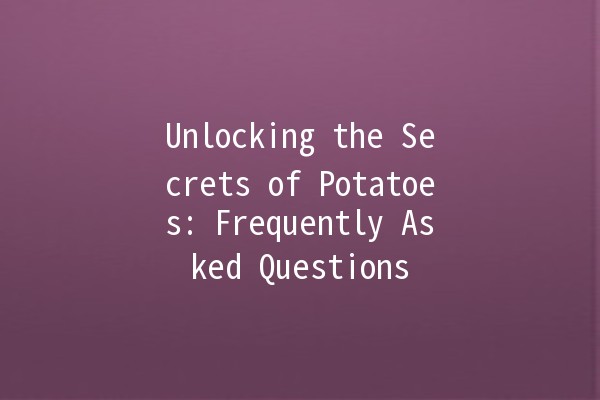When it comes to one of the most versatile and beloved vegetables in the world—potatoes—questions abound! Whether you're a curious food enthusiast, a home cook, or an aspiring chef, understanding the myriad aspects of potatoes can enhance your culinary experience. This article aims to tackle several common inquiries related to potatoes and offer practical tips for boosting your productivity in the kitchen.
Tips for Enhancing Productivity in the Kitchen with Potatoes
Potatoes come in various types, each suited for specific cooking methods and dishes. For instance, Russet potatoes are perfect for baking and frying, while waxy varieties like Yukon Gold are ideal for boiling and roasting. Knowing which type to use can streamline your cooking process and yield better results.

Application Example: If you are making mashed potatoes, opt for starchy varieties like Russets. The high starch content results in a creamy texture. On the other hand, if you're preparing a potato salad, choose waxy potatoes that hold their shape well.
Cooking large quantities of potatoes at once can save you significant time during busy weeks. You can boil, roast, or even airfry batches of potatoes and store them in the refrigerator or freezer for future meals. They can be easily reheated and incorporated into various dishes.
Application Example: Prepare a large pot of mashed potatoes, and use half for dinner. The remainder can be formed into potato cakes or used as a base for shepherd's pie later in the week, reducing overall preparation time.
Proper storage of potatoes can extend their shelf life, ensuring they are always ready for cooking. Store them in a cool, dark place, away from moisture and sunlight. Keep them in a breathable bag or basket, and avoid storing them alongside onions, which may cause sprouting.
Application Example: Create a designated storage space for your potatoes in a pantry or cellar. This will help maintain their freshness and prevent spoilage, leading to less food waste.
Potatoes are incredibly adaptable. Explore various cooking methods to prevent monotony and elevate your meals. Steaming, grilling, baking, and slowcooking can bring out different flavors and textures, allowing you to enjoy potatoes in diverse ways.
Application Example: Instead of always frying potatoes, try ovenbaking them with a sprinkle of herbs for a healthier take. This technique can produce a crispy exterior and fluffy interior, making for an enticing dish.
Include potatoes in your weekly meal plans to ensure a balanced diet. They can serve as a side dish, main ingredient, or even a snack. Their versatility allows them to fit into various cuisines and dietary preferences.
Application Example: Plan out your week’s meals by integrating potatoes into different dishes, such as potato soup for lunch, a potato gratin for dinner, and baked potato snacks in between. This aids in grocery shopping and promotes healthier eating habits.
Frequently Asked Questions about Potatoes
What Are the Most Nutritional Benefits of Potatoes?
Potatoes are rich in essential nutrients, including vitamin C, vitamin B6, potassium, and dietary fiber. They are naturally low in calories and fat, making them a great addition to a balanced diet. Including potatoes can help support immune function, maintain healthy blood pressure levels, and promote digestive health.
How Do I Know When Potatoes Are Bad?
Potato spoilage can be identified through visual and tactile inspection. Look for green spots, soft areas, or sprouting eyes. If the potato feels mushy or has an offputting smell, it’s best to discard it. Always prioritize fresh potatoes to ensure the best taste and nutritional value.
Can I Eat the Skin of a Potato?
Absolutely! Potato skins are packed with nutrients, including fiber and antioxidants. As long as they are clean and properly cooked, the skin can enhance the nutritional profile of your meal. Always wash potatoes thoroughly to remove any dirt or pesticides, especially if you plan to eat the skin.
Are Potatoes Suitable for a GlutenFree Diet?
Yes! Potatoes are naturally glutenfree, making them an excellent option for individuals with celiac disease or gluten sensitivity. They can be used creatively in various glutenfree dishes, from mashed potatoes to potato flour for baking.
How Can I Prevent Potatoes from Turning Brown After Cutting?
To prevent oxidation and browning, submerge cut potatoes in a bowl of cold water with a splash of lemon juice or vinegar. Alternatively, you can store cut potatoes in the refrigerator until ready to use. This helps maintain their color and texture until cooking.
What Are Some Creative Recipes for Using Leftover Potatoes?
Leftover potatoes can be transformed into various dishes, ensuring none goes to waste. Some delicious options include potato pancakes, casseroles, or even hash browns. You can also mix them into soups or stews for a hearty meal.
Potatoes are not only a staple food item but also a versatile ingredient that can enhance many dishes. By mastering various cooking techniques, understanding storage methods, and incorporating potatoes into your meal planning, you can significantly boost your productivity in the kitchen. Use the tips and tricks outlined in this article to make the most of your potato experience. With this newfound knowledge, you'll be ready to whip up delicious potatobased meals that are sure to impress! 🥔💪